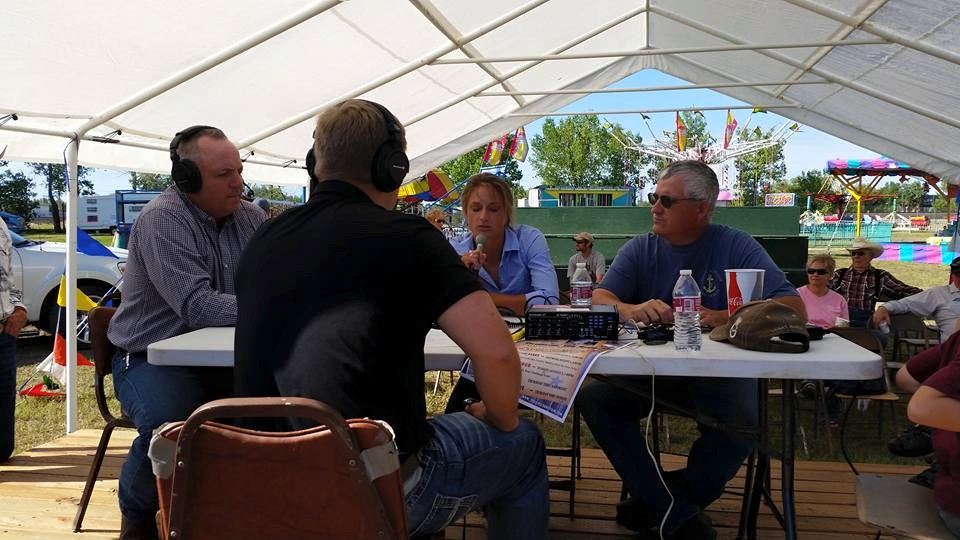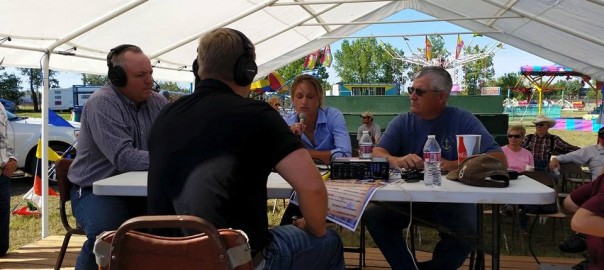Small, Not Dying: A Montana county develops a future while preserving its past

Pictured left to right: Rancher Mark French, Taylor French, and Larry Smith during live Voices of Montana broadcast at the 100th Phillips County Fair- the longest continuously running fair in Montana. Photo by KMMR Radio’s Greg Kielb
by Taylor French
The decline of rural America has been a topic of discussion for many years and in many forums. Recent articles have reported that the millennial generation continues to filter into metropolitan and suburban areas (NPR 2014), while nearly two-thirds of the nation’s counties have witnessed population declines (Frey 2013). The United States Department of Agriculture Economic Research Service (USDA-ERS) and independent conservative bloggers have also chimed in with community and business assessments for rural districts to compete with urban districts (USDAERS 2012; Bacon 2014). Yet amidst the CEOs, policy makers, and analysts in metropolitan centers who attempt to identify, categorize, and correct the problem of small town America, rural communities are disproportionately absent from the dialogue.
Montana is predominantly comprised of rural or nonmetro communities. While many of the state’s counties have fluctuated in population depending on the tourism and natural resource industries, Phillips County would at first glance appear to typify the decline of rural populations.
Over the past 40 years, the agriculturally-based county experienced a population decrease of 11%: High interest rates in the 1970’s and ‘80’s coupled with a debilitating drought resulted in the foreclosure of many farms and ranches, which was followed by the bankruptcy of the Zortman and Landusky mines in 1998 and an exodus of nearly 1000 individuals. Contrary to most analyses, the apparent emigration of residents from the area has actually enhanced its attractiveness for environmental interest groups and the federal government because of one critical factor: Phillips County, along with its nearest neighbouring counties, contains one of the largest intact natural grasslands remaining in the United States. The low population density and unique environmental conditions have identified the region as ideal for a National Monument designation and for a wildlife refuge, each of which has been touted to boost the local economy through tourism and employment opportunities.
Rather than rely on a savior from Washington, residents of Phillips County have been choosing a more self-sufficient route to ensure the survival of their community. Since 2004, the non-profit American Prairie Reserve (APR) has been purchasing ranches in the area in an effort to create a 3.5 million-acre wild bison reserve, and has acquired 305,000 acres of private and public land to date. Pete Geddes, an APR managing director, has said that while not responsible for the population decline, they are responsible for the change in environmental land use strategy (Lubove 2013). In 2014, local community members decided that enough agricultural land had been repurposed for Reserve land. A large ranch owned by an out-of-state investor was listed for sale in Montana Land Magazine by a non-local broker, and no single rancher in the area could afford the purchasing price. Cognizant that the APR, with millions of dollars of beneficiary funding, would seek to add the ranch to its current holdings, a group of ranchers and nonranchers collaborated to create 15 shares in what would become the Little Big Warm Ranch LLC. Over several months, the seller worked with the shareholders to assess necessary improvements and the purchase was finalized December 15th, 2014.
A priority for the Little Big Warm Ranch LLC was to provide a rare opportunity for young ranchers to be involved in land ownership. Older operators and young shareholders alike recognized the importance of maintaining more of the land in agriculture to support returning families. Contrary to the misconception that ranchers are aging and young inheritors are seeking to sell-out, three of the 15 shares are held by individuals under the age of 30 who intend to continue their families’ tradition. Siblings of the RCR Ranch LLP are highly involved in their family’s own ranch, yet were eager for an opportunity to build equity. Tyler French, the youngest single shareholder, is a captain in the United States Air Force, but was raised on a ranch in South Phillips County and hopes to return when his term of service is complete. For Tyler, the investment in the Little Big Warm Ranch LLC ensued after previous attempts to establish personal connections with ranches in the area that might be interested in selling, but with no immediate options. He knows that the share he holds is a good investment and learning experience, and trusts in the competence of senior and local shareholders to manage and grow the business.
A second priority for purchasing the ranch was investing in the local economy and maintaining community support. Just as the APR self-promotes the Reserve as a local investment for businesses and services in the area, the Little Big Warm Ranch LLC outlined in its prospectus a commitment to annual maintenance and improvement of the land, as well as keeping the ranch open to the local community for hunting. Mark French, manager of the Equity Cooperative and a shareholder in the Little Big Warm Ranch LLC stated that, “when the ranchers are profitable, [the Coop] is profitable;” shareholders recognize that utilizing local materials and expertise is not only more cost effective, but maintains a healthy local economy, which is vital to sustainable ranching operations. The Little Big Warm Ranch LLC has also applied for Block Management status so that the land will be available to local gamesmen, as well as return consumer revenue to local vendors.
During the same time period a second land purchase was sought after by both ranchers and the APR, this time on a smaller scale. The Double O Ranch in South Phillips County had been leasing an adjacent half-section, and had indicated to the owner an interest in purchasing it if the land should ever come up for sale. In contrast, the APR does not have any contiguous borders with the contentious parcel. When the half-section was listed in the fall of 2014, the Double O Ranch immediately met the purchase offer, which was higher than the market taxable value. The offer was accepted by the owner, despite pressure from the APR. Again, the commitment of the seller to maintain the purpose of the land in agriculture was the predominant opportunity for local ranchers to participate in the acquisition. Both the Little Big Warm Ranch LLC and the Double O purchase display the vested interest and commitment of local residents to their community, to preserving the traditional use of the land, and to maintaining a presence in the area.
Ranchers, however, are not the only community members interested in the economic and social development of Phillips County. Malta is the county seat and largest municipality with 1,967 persons (2013 Census estimate), and has experienced recent growth in the local economy and in the numbers of young families. The PhillCo economic development agency for the county reported a count of 70 young families in its community needs assessment, and enrollment numbers for the pre-school and elementary school have increased. Despite the population loss in the county over the past 40 years, a rebound is being observed for the first time in decades: the decline in population has slowed dramatically in the past 15 years, with a net migration rate of -4.8% between 2000 and 2010, and only -1.8% from 2010-2013 (USDA-ERS). Furthermore, in 2013 the number of persons in the county under 18 years exceeded that of persons over 65 years (22.2% and 20.6%, respectively), and the 2014 population estimate actually exceeds that of 2013 (US Census Bureau).
The growth trend is not the result of government intervention or APR presence, but of a community commitment to support younger generations and provide amenities available in metro centers. The ‘brain drain’ of skilled workers to metropolitan areas is a common explanation for urbanization (Bacon 2014); yet Malta has seen not only a return of young labourers, but of a skilled and technologically-trained workforce. The pharmacist, loan officers, accountants, the master electrician and apprentices, teachers, retail managers, as well as many independent entrepreneurs have all been raised in and returned to Malta following higher education out-of-county. These young families in turn support the local economy: Malta boasts two hardware and lumber stores, three agriculture cooperatives or service centers, and thriving shopping facilities such as coffee shops, nail and hair salons, a gym, tanning studio, furniture store, museums, and three full service banks. The Secretary of the Malta Area Chamber of Commerce and Agriculture reported a higher Christmas sales’ revenue than in the previous three years: the Christmas Scrip program, which offers ‘Christmas cash’ to be used at local merchants, retained $260,000 in the local economy during the 2014 Christmas season. The Malta Chamber is working toward increasing the Christmas Scrip numbers even further in 2015.
The return of young families and the commitment of established families to Phillips County have resulted in a strong sense of solidarity. Agriculture is the largest industry in the county, but both ranchers and non-ranchers alike recognize the importance of preserving the community in its entirety for future generations. Many families can trace their heritage back more than four generations, knowing where grandparents were born and laid to rest. The land is a living history; an irreplaceable treasure that cannot be repurposed. Despite efforts from external forces to dictate the best management and land use strategies for the region, residents maintain a strong sense of responsibility for the land and for their families, and hope that purchases like the Little Big Warm Ranch LLC will serve as a template for competing with interest groups like the APR.
If Phillips County is a model for any discussion, perhaps it should be that just because a community is small, does not mean that it is “dying.” The best opportunity for resolving a declining small town America is to involve those most intimately affected, the rural community members, in the deciding their future.
Taylor French
(Note- a version of this column was also printed in The Billings Gazette, and can be found by clicking here.)
